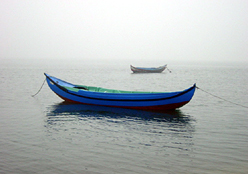Aveiro was originally founded in the
time of the Roman Emperor Marcus Aurelius. The development of the salt
industry, agriculture, and fishing, and the first cod-fishing
expeditions to distant Newfoundland in 1501 brought the city a period of
great prosperity in the 16th century. However, in the winter of 1575,
heavy storms destroyed the deep channel that had once linked the marshy
lagoon known as Ria to the sea. This effectively destroyed the city's
sea trade. The Ria was not joined to the sea again until the early part
of the 19th century.
On the lagoon, brightly painted swan-necked boats
traverse the waters. Called barcos moliceiros, the flat-bottomed
vessels carry fishers who harvest seaweed used for fertilizer. They're
ever on the lookout for eels, a regional specialty, which they catch in
the shoals studded with lotus and water lilies. Outside the town are
extensive salt pits, lined with fog-white pyramids of drying salt.
